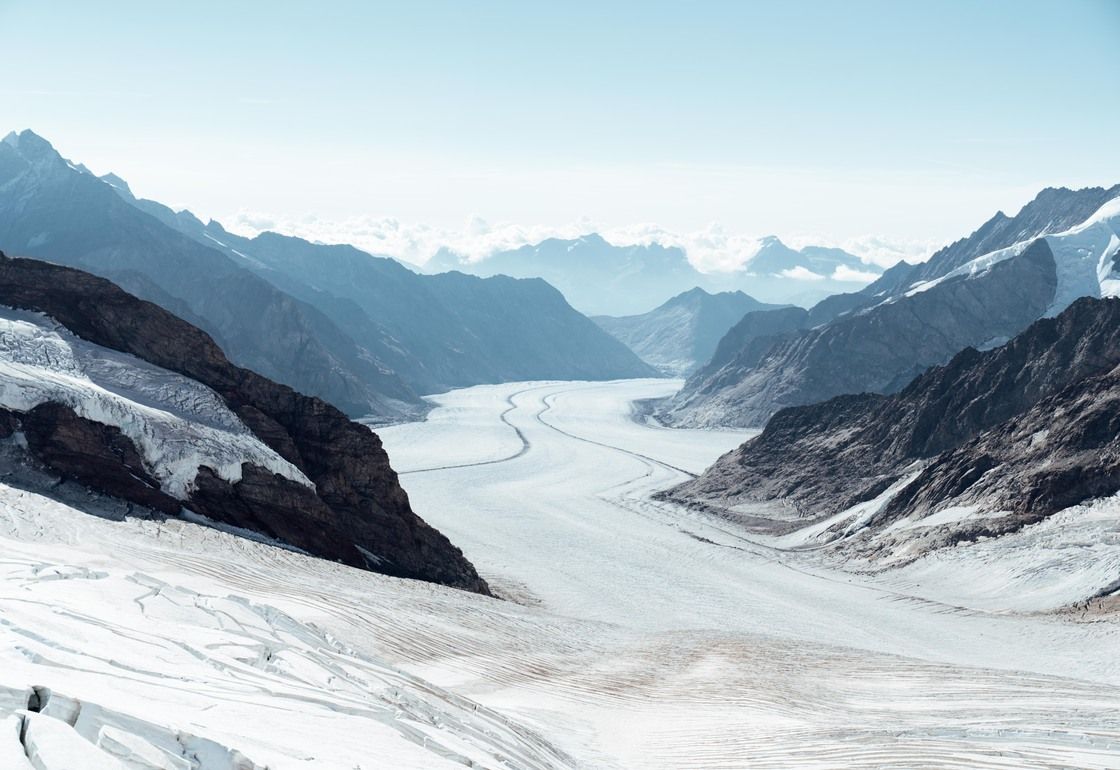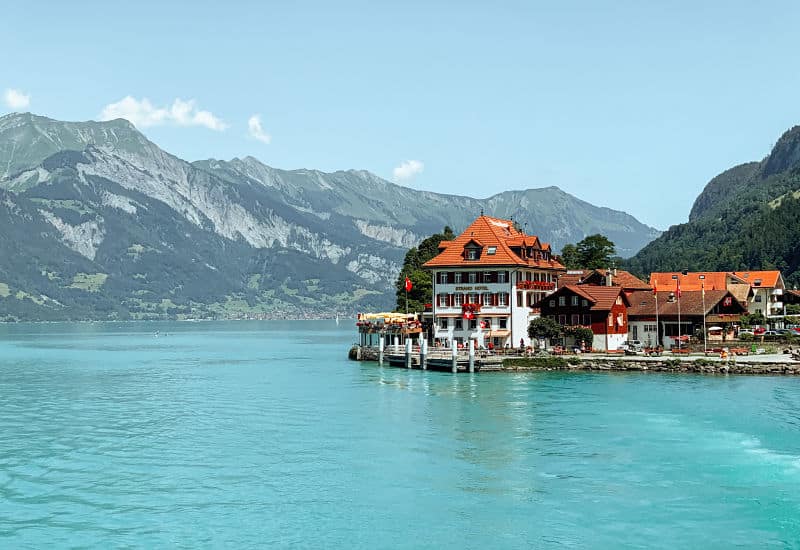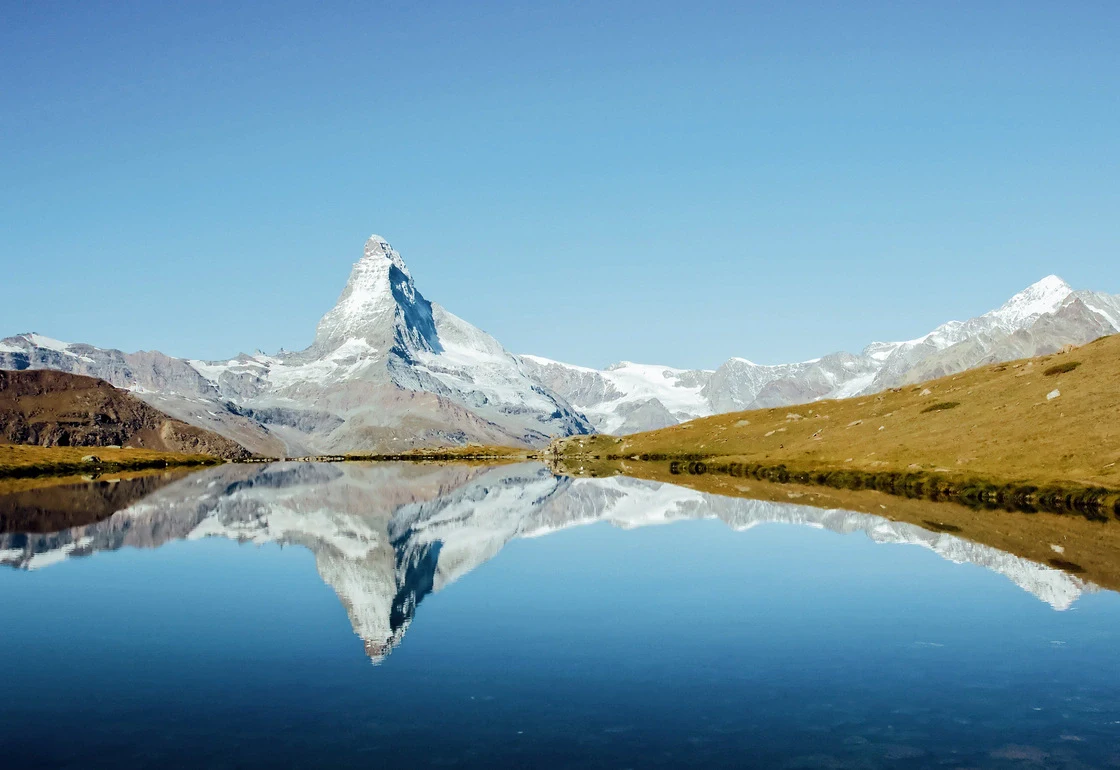Hot to get to Switzerland and move around
We did this trip in a camper van and drove all the way from Madrid. Except for the first night, we stayed at campings throughout the rest of the journey. That said, you can absolutely do the same route with a regular car instead of a camper. The type of vehicle doesn’t affect the itinerary.
If you don’t have the time (or the energy) to drive all the way from wherever you are, the best way to do this 7-day road trip through Switzerland is to fly into Geneva and rent a car there. You could also look into flying into a nearby city (like Lyon, for example) and picking up a rental there. It might actually be cheaper.
Before diving into the day-by-day itinerary, there’s one more thing you should know: this is a circular route. We entered Switzerland through Geneva and exited just before reaching Lake Geneva, since we wanted to stop by Chamonix. But you’ll most likely end your trip back in Geneva.
If you do decide to fly in and rent a car, I recommend checking flights on Skyscanner and comparing rental prices on Auto Europe or Discover Cars. Both platforms are super helpful for finding the best deals.
Places to visit in Switzerland in 7 days
Here’s a day-by-day breakdown of our one-week road trip through Switzerland. Get ready to explore breathtaking natural spots and some of the most charming little towns you’ve ever seen.
But before we dive into the itinerary, here’s a quick overview of where we spent each night:
- Bulle (near Gruyères): 1 night → Search hotels in Bulle.
- Frutigen: 1 night → Search hotels in Frutigen.
- Wilderswil (near Interlaken): 2 nights → Search hotels in Interlaken.
- Innertkirchen (Interlaken area): 1 night → Search hotels in Innertkirchen.
- Raron (close to Zermatt): 2 nights → Search hotels in Raron.
Day 1 of our 7-day itinerary in Switzerland
Let’s kick off our first day in Switzerland! We arrived late in the day, so we only had a few hours to explore. We spent that time wandering around the beautiful area near Chillon Castle.
Chillon Castle
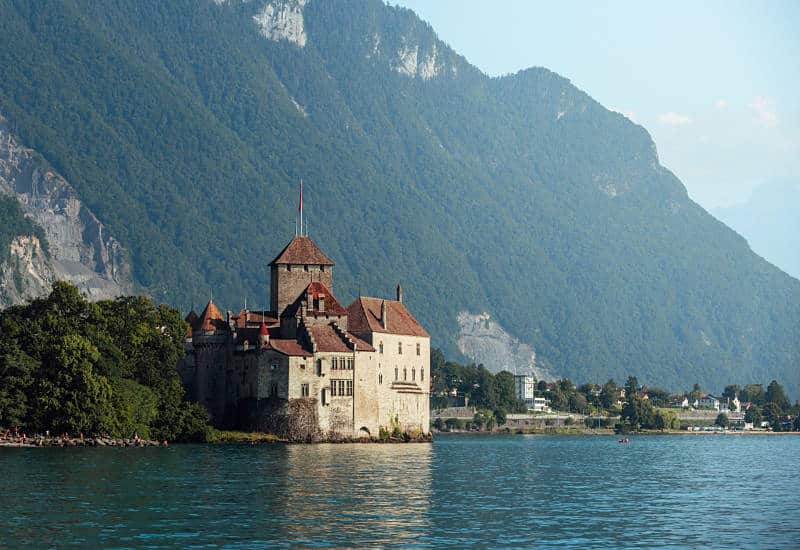
We entered the country in the afternoon, therefore, on our first day in Switzerland we only visited Chillon Castle, located at the eastern end of Lake Geneva, in the town of Montreux.
It is one of the most important and most visited historical buildings in Switzerland. It is made up of a total of 25 buildings and 3 courtyards. If you wish to visit its interior, you can walk through its underground vaults, its many rooms and bedrooms, which still retain their original decoration.
Not only do the wonders of the castle themselves attract hundreds of tourists daily, its scenic location is another great attractions. In fact, we did not visit the interior because it was already closed when we arrived. We focused on getting to know its exterior and walking around the surroundings of the castle.
If you feel like doing the same, I recommend walking on the pathway along the lake that leads from the castle to the right. After walking for 10 minutes, you will see a small cafeteria (Le Cabanon de Mam‘s) that has a very nice view of Château de Chillon.
If you continue walking for another 25 minutes, you will reach the center of Montreux, where you can stroll through its streets or take a boat trip on Lake Geneva.
After visiting Chillon Castle and its surroundings, we left Montreux behind to head towards Gruyères. Our idea was to sleep in a campsite near this famous Swiss town but they were all booked. We ended up sleeping in a small forest located a few kilometers from Gruyères.
- Journey: From Geneva to Gruyères.
- Night: Little forest on the outskirts of Bulle (exact location). Check available hotels in Bulle. Recommended hotel: Hôtel Restaurant le Gruyérien.
🏥 It is recommended to purchase travel insurance for Switzerland, since it is a very expensive destination and you never know what can happen. I always use and recommend Heymondo travel insurance, in which I can offer you a 5% discount on your next travel insurance policy.
Day 2 of our 7-day itinerary in Switzerland
On day two, we visited the charming village of Gruyères, were blown away by the views at Jaunpass, and discovered one of the most beautiful lakes in the country: Blausee.
Gruyères

We started our second day of the trip visiting Gruyères, one of the most beautiful towns in Switzerland. We parked the camper in one of the lots located on the outskirts of this small town and began the visit around 10:00h in the morning.
I recommend going to Gruyères as early as possible as it is a very popular place among tourists and it quickly gets crowded. Also, it is a very small town, so it can get quite hectic if you visit it with a lot of people.
Apart from getting lost in the little streets of the town, be sure to visit the Castle of Gruyères. It is a fortified castle from the 13th century. You can visit the castle inside or simply enjoy the incredible views from its freely accessible terrace.
Another essential stop is the Church of Saint Theodule and the cemetery located next to it. I recommend you walk around. From here, you can see a very nice postcard-like view of the castle. Despite Gruyères being very small, it has two museums that may interest you: the HR Giger Museum and the Tibet Museum.
We prefered to sit in one of the restaurants on the main street to enjoy a warm coffee but you can do both.
Jaunpass

We put the Blue Lake, known as Blausee, in our GPS and continued with the tour. The views from the road were amazing so we decided to stop at a place called Jaunpass. From here, you can appreciate a beautiful landscape with featuring the Gastlosen peaks, a place that reminded me a lot of my trip to the Dolomites.
This is the exact location of the Jaunpass car park. Parking is free if you spend less than an hour. We took a short walk around the area, enough to enjoy the beauty of the place.
Blausee (Blue Lake)

After traveling a few kilometers, having a picnic lunch next to a river, and traveling a few more kilometers, we arrived at our last stop of the day, the Blausee, which translates to Blue Lake.
As you can already imagine from the name, the water in this lake is an incredible deep blue. After leaving the car in the car park and paying the entrance fee (9-11 CHF per person), you will have to walk 200 meters through the forest until you reach the famous lake. The landscape is out of this world.
From the lake, I recommend you take one of the trails available in this 20-hectare natural park. The shortest walk, and the one we did, was the one that goes around the lake. If you have more time, you can walk other longer paths that takes you into the forest.
Another activity that you can do in Blausee is a boat trip on the lake, which is included with the ticket. There is a hotel with a spa and restaurant, a small museum, a park for children and a barbecue area.
- Journey: From Gruyères to Frutigen.
- Night: Camping Frutigresort. Check available hotels in Frutigen. Recommended hotel: Hotel Landhaus Adler.
Day 3 of our 7-day itinerary in Switzerland
On to day three of our Switzerland adventure! We spent the day visiting the stunning Oeschinensee, which quickly became one of my favorite places in the entire country.
Oeschinensee

We continue with one of the highlights of this trip: Oeschinensee, a huge lake of glacial origin. It has intense turquoise-colored water surrounded by green mountains and snow-capped peaks. It is one of the most beautiful lakes in Switzerland and an essential stop if you like nature and walking.
From Frutigen, the town where we spent the night, we only had to travel 13 kilometers in the van to reach Kandersteg, the starting point to visit Oeschinensee Lake. Once you leave the car in the parking area, you have two options, you can go up by cable car (36-40 CHF round trip) or walk up to the lake.
From Kandersteg to Oeschinensee it is about 3 km uphill. We chose to go up and down by cable car. Once you arrive at the top station, you have to walk 25 minutes to reach the lake. There is also the option of taking a shuttle bus for 8 francs.
What to do at Lake Oeschinen?

There are different activities to do in Oeschinensee, depending on your tastes and your energy level.
We chose to do one of the available hiking routes, specifically route 8. It is a 3-hour circular route (we took a little longer) that takes you along one of the slopes located next to the lake. The views are amazing but be prepared to go up and up and then down. There are other easier hikes and others even harder.
If you feel like having a more relaxed visit, you can go directly to the lake and enjoy a swim, take a boat ride, sunbathe, have a picnic or even a barbecue. There is also a restaurant and food stalls.
Oeschinensee is a very beautiful place that offers different activities, so I recommend you spend a large part of the day there and take a hike one of the trails and then enjoy a refreshing swim in the cold waters of the lake. Do not forget to bring your swimsuit, sun cream, enough to drink and something to eat.
By the way, in the cable car station located above, apart from bathrooms and some food stalls, one of the famous alpine slides awaits you.
After hiking trail 8 (and being exhausted), we went down to the parking lot in the cable car, we got on the vans and we started driving towards Interlaken. We ended up finding a campsite in Wilderswil, a small town on the outskirts of Interlaken.
We couldn’t call it a day without taking a dip in Lake Brienz first. After all that hiking, we definitely needed it before dinner and heading to bed!
- Journey: From Frutigen to Wilderswil (Interlaken).
- Night: Camping Oberei. Check available hotels in Interlaken. Recommended hotel: Hotel Rössli.
Day 4 of our 7-day itinerary in Switzerland
Our Swiss adventure continues! Day four was a packed day. We explored Lauterbrunnen, Wengen, the Trümmelbach Falls, and wrapped it up at Lake Brienz (Brienzersee).
Lauterbrunnen

The fourth day of this 7-day Switzerland itinerary was spent visiting the famous town of Lauterbrunnen and its surroundings.
Lauterbrunnen is nestled in one of Switzerland’s most picturesque valleys. Snow-capped peaks and towering cliffs dotted with waterfalls create one of the country’s most iconic scenes. Out of the 72 waterfalls in the area, Staubbach Falls, right in the village, is the standout. It’s one of the highest free-falling waterfalls in Europe.
The best way to experience Lauterbrunnen is by wandering its streets on foot, which is exactly what we did. We walked away from the village center to find a higher spot with great views. We ended up on a trail called Heimegg, where we soaked in some truly stunning scenery.
Wengen

Later, we took the cogwheel train up to the little village of Wengen, which is one of the top things to do in the Lauterbrunnen Valley.
Wengen sits at 1,274 meters (about 400 meters higher than Lauterbrunnen) and is a popular vacation spot. It’s also the gateway to many hikes in the Jungfrau region. After strolling through the village and soaking in the incredible valley views, we headed back down to Lauterbrunnen.
Trummelbach Waterfall

Next up, we visited the amazing Trümmelbach Falls. If you want to witness the sheer power of rushing water, this place is a must-see.
You can walk through a series of caves inside a mountain and follow the path the water has carved out. It’s Europe’s largest underground waterfall, fed by the meltwater from the Jungfrau glacier.
It’s hard to put into words just how incredible this waterfall is, so I definitely recommend seeing it for yourself. One tip: bring a light jacket. Even if it’s warm outside, it’s pretty cool inside the caves.
Entrance to Trümmelbach Falls costs 16 CHF per person.
Mürren
Although we did not visit this place, another tourist town found in this valley is Mürren. It is located at 1,650 meters above sea level. The village is the highest year-round populated village in the canton of Bern. It can be reached from Lauterbrunnen (cable car and train) or from Stechelberg (cable car), located at the end of the valley.
In Mürren you can take a walk through the town, appreciate the views, take the funicular up to Allmendhubel or go hiking in the surrounding area.
Brienzersee Lake
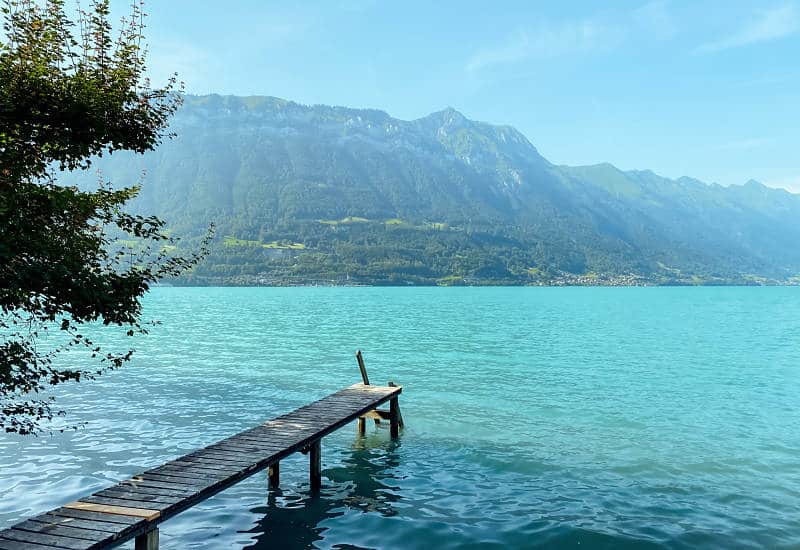
We enjoyed our swim in Lake Brienz so much the day before that we didn’t hesitate to go back again. I mean, who wouldn’t want to take a dip in turquoise, refreshing water after a full day of sightseeing under the summer sun?
If you want to follow our lead, head to the little village of Bönigen and drive along the road next to the lake. You’ll find plenty of spots where you can park and jump right in for a swim.
- Journey: Wilderswil – Lauterbrunnen – Wilderswil.
- Night: Camping Oberei. Check available hotels in Interlaken. Recommended hotel: Hotel Rössli.
Day 5 of our 7-day itinerary in Switzerland
Here comes day five of our trip in Switzerland. That day, we visited Grindelwald and the First Cliff Walk.
We didn’t visit Jungfraujoch, the “Top of Europe”, on this trip, but I had the chance to go on a later one and it’s absolutely worth including in this itinerary. If you decide to go, I highly recommend doing it first thing in the morning so you still have time to head up to First later in the day.
Grindelwald

One of the places that impressed me the most on my trip to Switzerland for 7 days was Grindelwald, a small town surrounded by green meadows, forests and snow-capped mountains, including the Eiger and the Wetterhorn. It looks like something out of a fairy tale!
The reason we ended up in this town was because we wanted to visit Bachalpsee Lake. I’ll explain how to get there below.
Bachalpsee Lake

To get to Bachalpsee Lake, you first have to go to the small town of Grindelwald.
If you’re already there, make your way to the Grindelwald-First cable car. You will have to buy the ticket that takes you to the last stop, First. The return ticket costs 76 CHF. If you want to skip the line to buy the tickets, you can buy them in advance now.
Once in First, it’s time to walk for an hour to the lake. Before or after visiting the lake, don’t miss the First Cliff Walk (it’s included in the price of the cable car). It is an iron walkway anchored to the cliff that ends up entering the void and provides on of the most incredible views in Switzerland.

Alright, time to start the hike to Lake Bachalpsee! It’s a relatively easy, one-hour walk that’s great for all ages.
Once you reach the lake, I highly recommend pushing just a little further and follow the trail around the lake to the far end. There’s a bit of an uphill climb, but the view from that side is absolutely worth it. You’ll get a stunning panorama of Bachalpsee surrounded by green meadows and rolling hills, with snow-covered peaks towering in the background.
If you’re looking to save a bit of money, one option is to take the cable car up and hike back down. Just be kind to your knees! Another fun option we saw is riding down on a kind of mountain trike you can rent right there. It’s also possible to hike up and down from Grindelwald, but honestly, that’s a pretty intense trek.
In this other post, I go into more detail about how to get to Bachalpsee.
Jungfraujoch, Top of Europe

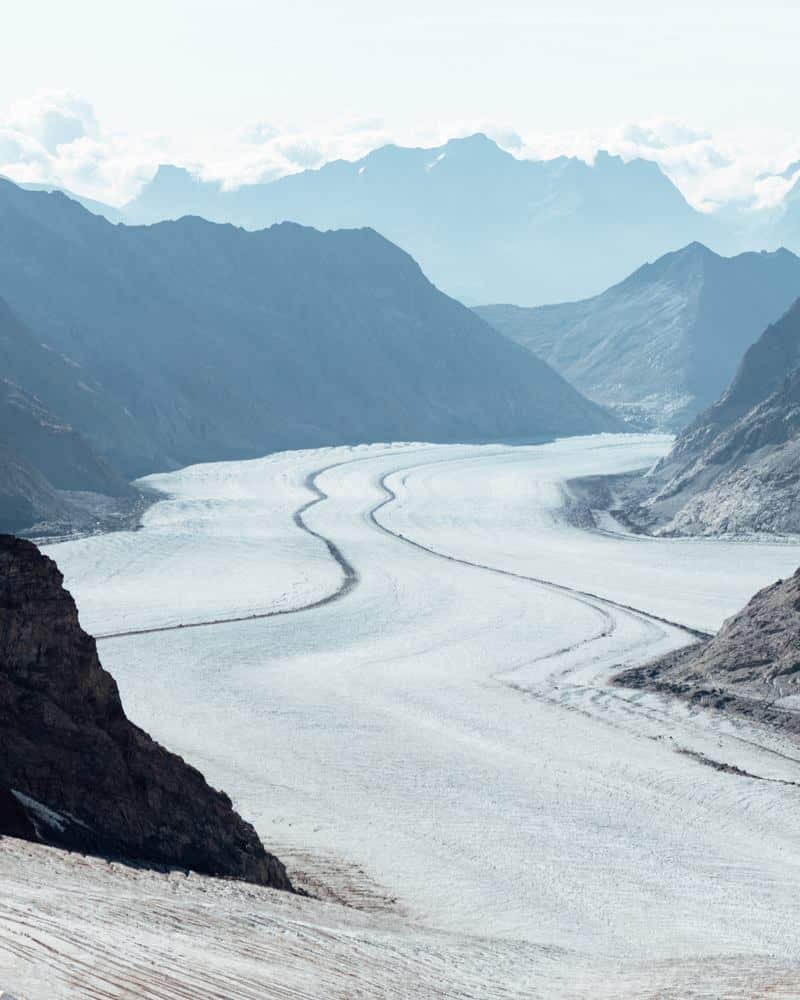
Would you like to visit the highest train station in Europe? If so, you have to go to the Jungfraujoch station, located at 3,454 meters above sea level.
Getting here is neither easy nor cheap, but it’s well worth it. We could not do it but it remains pending for a future trip to Switzerland. Update: I was able to go on my last trip to Switzerland and it’s amazing!
The fastest way to get to the Jungfraujoch is from Grindelwald, where you have to take a cable car up to the Eigergletscher glacier. From there, you have to take the Jungfraubahn train to Jungfraujoch.
If you want to avoid any hassle during the trip, I recommend buying the ticket to Jungfraujoch now. Another even easier option is to book an organized Jungfraujoch tour from Interlaken.
If you are visiting Jungfraujoch and also want to go up to Bachalpsee Lake, you should go up to the famous train station early in the morning and visit the lake in the afternoon.
When we finished our visit to Grindelwald, we got in the van and began our journey to Camping Aareschlucht, in a town called Innertkirchen, located very close to Aareschlucht (Garge de l’Aare), a place we visited the next morning.
We took a drive around the surroundings and ate traditional food at a local restaurant.
- Journey: Wilderswil – Grindelwald – Innertkirchen.
- Night: Camping Aareschlucht. Check available hotels near the Garge de l’Aaare. Recommended hotel: Ufem Egg Ferienwohnungen.
Day 6 of our 7-day itinerary in Switzerland
We kicked off our second-to-last day in Switzerland with visits to the Aare Gorge (Aareschlucht), the historic Grimsel Hospiz hotel, and the Goms Suspension Bridge.
I also want to mention the Aletsch Glacier, as it makes for a really interesting activity. If you plan to include it, I’d recommend visiting the glacier before heading to the Goms Bridge. That said, if you’re planning to go up to the Top of Europe, you might choose to skip this one, since you’ll also get to see the glacier from the other side at Jungfraujoch.
Aareschlucht

One of our favorite stops during our one-week trip through Switzerland was Aareschlucht, the Aare Gorge. It actually wasn’t even on our original itinerary, but the owner of our camping suggested it, and we’re so glad we took her advice! The gorge features a 1,400-meter-long wooden walkway built right into the cliffs of this stunning canyon carved by the Aare River.
At its narrowest point, the gorge is just one meter wide, while the widest section stretches to 40 meters. The cliffs rise up to 180 meters above, and the water can be as deep as 5 meters.
The walk is absolutely beautiful. You’re literally inside the gorge, walking through tunnels and hugging the cliffside while taking in the dramatic scenery and the gorgeously turquoise river below. Most people complete it in about 45 minutes. You could do it faster, but chances are you’ll stop often to soak in the views.
There’s an entrance and exit at both ends of the walkway, so you don’t have to walk it in both directions unless you want to.
I’d recommend starting from the west entrance, walking through the gorge, exiting at the east side, and then either hopping on the underground train that runs along the river or taking the marked trail back to the parking lot. In our case, our campground was right by the east entrance, so we took the train to the west side and then walked back through the gorge.
The only downside is that the walkway can feel a bit narrow (it’s only about a meter wide) so it can get a little tight when people are walking in both directions. Other than that, we absolutely loved it.
Admission costs 12 CHF.
Grimsel Hospiz Hotel
After exploring this beautiful spot, we hopped back into the vans and set our GPS for the Goms Suspension Bridge. It was time to leave the Interlaken area and head south. Ahead of us: 60 kilometers of absolutely stunning mountain roads leading to the famous bridge.
Along the way, we passed a series of massive reservoirs. As the road began to wind its way uphill and the scenery became even more breathtaking, we couldn’t resist stopping at a viewpoint.
From there, we had an incredible view of Lake Grimselsee and Lake Räterichsbodensee, with the historic Grimsel Hospiz hotel nestled between them. This popular hotel once served as housing for the miners who worked in the area.
Goms Bridge

We finally made it to the Goms Suspension Bridge, an absolute must if you’re doing a 7-day itinerary in Switzerland, especially if you’re as into hanging bridges as I am.
It’s located in the commune of Ernen and is part of a 5 km circular hiking route, though you can just visit the bridge itself if you prefer. It’s free to access, and there’s a small parking area just across the road.
The bridge was built over the Rhône River in 2015 and stretches an impressive 280 meters in length. Crossing it is definitely an experience to remember!
Grosser Aletsch Glacier
Although we didn’t end up visiting this glacier ourselves, I still wanted to include it here since it’s definitely a spot worth checking out.
The Aletsch Glacier is the largest glacier in the entire Alps. One of the great things about it is how easy it is to access, making it a great option even if you’re not up for a long or strenuous hike.
All you have to do is head to the town of Fiesch and hop on the cable car, which will take you up to several viewpoints overlooking the glacier. You can even buy your ticket for the Aletsch cable car in advance.
If you plan to visit the glacier, I recommend doing it before heading to the Goms Suspension Bridge, since the cable car doesn’t run very late. On the flip side, the later you visit the bridge, the fewer people you’ll find (unless you go super early in the morning).
After all our stops that day, we started looking for a campground to stay for the next two nights. Most places were already full, but we eventually found a spot at Camping Simplonblick, located in a small town called Raron.
If you’re traveling by car, I’d suggest staying in Visp, Brig, or any of the nearby villages. They’re all good base options.
- Journey: Innertkirchen – Raron.
- Night: Camping Simplonblick. Search for available hotels in Visp and Brig. Recommended hotel: Schlosshotel.
Day 7 of our 7-day itinerary in Switzerland
On our last day in Switzerland, we explored Zermatt and took the cogwheel train up to the Gorner Glacier.
Zermatt

After grabbing breakfast in the camper vans and picking up some snacks for the day, we headed to Zermatt. You can’t drive all the way to this charming Swiss village, so first you need to go to a small town called Täsch. There, you park your car at the train station and catch a cogwheel train straight to Zermatt.
Once you’re there, don’t miss wandering through Zermatt’s cozy streets and checking out spots like Bahnhofstrasse, the main avenue, and the St. Mauritius Church.
Gorner Glacier and Riffelsee

From Zermatt, you can take several train and cable car trips to places like Rothorn, Matterhorn Glacier Paradise (Europe’s highest cable car), or Gornergrat.
We stopped by the tourist office right next to the train station to get some info (something I definitely recommend) and in the end, we chose to take the trip up to Gornergrat, which turned out to be an excellent decision.
The Gornergrat excursion is a cogwheel train ride that takes you to a huge viewpoint at 3,089 meters (about 10,141 feet) above sea level. There, you’ll find restrooms, a hotel, a shop, a café, and a restaurant. All while enjoying breathtaking views of the Gorner Glacier!
If you’re lucky enough to visit on a clear day, you’ll get a spectacular view of the famous Matterhorn (also known as Cervino), Switzerland’s most iconic mountain thanks to its pyramid shape. Unfortunately, we didn’t have that luck because it stayed covered in clouds all day.
The cogwheel train doesn’t just stop at Gornergrat; it has several other stops where you can hop off to explore and then catch the train back to Zermatt. Following the recommendation from the lady at the ticket office, we rode all the way up to Gornergrat first, then made a few stops on the way back down.

The second-to-last stop (and the spot you should definitely make your second visit) is Rotenboden. From there, I recommend taking a short walk to Lake Riffelsee, which is just about an 8-minute stroll.
This lake is famous for its stunning views of the Matterhorn. You can actually see the iconic mountain perfectly reflected in the water! It was a postcard moment I was really looking forward to, but sadly, as I mentioned earlier, the sky was cloudy all day, so I missed out.
Besides visiting the lake, I suggest exploring the various trails around this stop, especially to get a closer look at the Gorner Glacier again. The view from here is quite different since you get to see the entire glacier tongue. Absolutely breathtaking!
There are two more stops before heading back to Zermatt, but we skipped them because it started pouring rain and the peaks were barely visible.
The round-trip cogwheel train ticket to Gornergrat costs 132 CHF per person. You can buy your tickets in advance.
Once back in Zermatt, we grabbed a coffee, took a walk in the rain, then caught the train to Täsch to get back to our camper and head to our campsite.
The next morning, we headed off to Chamonix (France) via Martigny, wrapping up our one-week camper trip through Switzerland.
- Journey: Raron – Täsch – Raron.
- Night: Camping Simplonblick. Search for available hotels in Visp and Brig. Recommended hotel: Schlosshotel.
Tips for your one-week trip to Switzerland
Before I wrap up this guide on what to see in Switzerland in a week, I wanted to share some handy tips to help you plan your trip.
Here’s what to keep in mind before you go:
- To drive on Swiss highways, you need to buy a vignette (toll sticker). It costs 40 CHF and can be purchased at gas stations, post offices, highway service stations, and more. You can also get an e-vignette online.
- Many phone carriers don’t include roaming for Switzerland. If you want reliable internet, the easiest option is to get an eSIM for Switzerland. That way, you’ll have internet as soon as you arrive without any hassle. You can get one with a 5% discount here.
- If you’re planning to travel by public transport around the country, the Swiss Travel Pass is your best bet. It gives you unlimited access to Swiss public transportation. You can buy it here in advance.
- Even if you’re not using public transport a lot, check out the Swiss Half Fare Card. It gives you 50% off on most transport, including cable cars and funiculars.
- Since many spots in this itinerary are in the Jungfrau region, the Jungfrau Travel Pass might interest you. It covers local transport around the area (though it doesn’t include Top of Europe), and offers discounted tickets. You can buy it here in advance.
- Some public parking spots require a blue parking disc to mark your arrival time. If you don’t have one, you can pick one up at police stations, tourist offices, and so on.
Map of our Switzerland road trip
Below you’ll find a detailed map showing our day-by-day route and all the places we visited during our trip through this amazing country.
If you end up having fewer days or prefer a slower pace, this 4-day Switzerland itinerary will be perfect for you. And if you want to plan your own trip, don’t miss this list of must-see spots in Switzerland.
I hope this article about our 7-day camper trip through Switzerland helps you plan your own adventure in this incredible country.
If you have any questions or want to share how your trip went, feel free to leave a comment or send me an email. See you next time!

